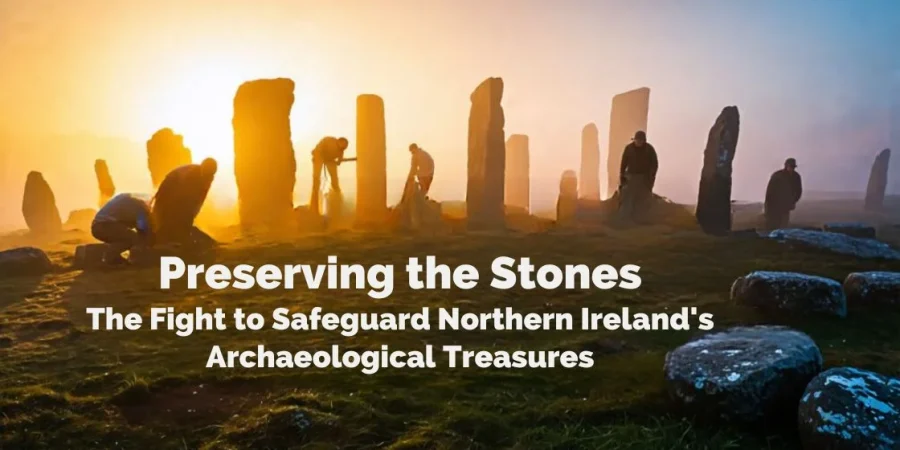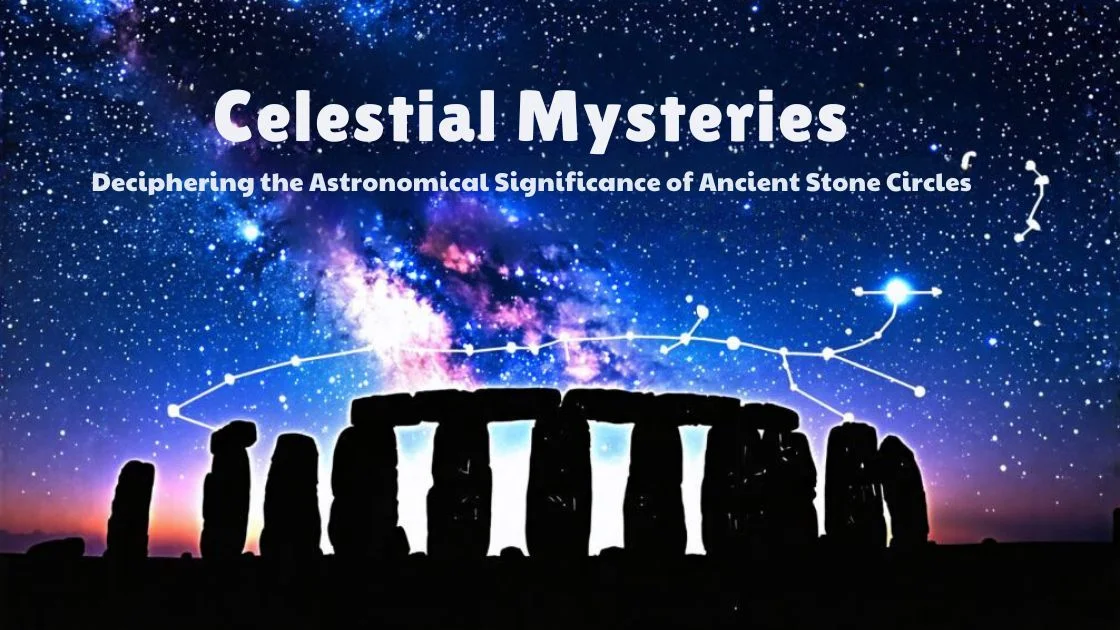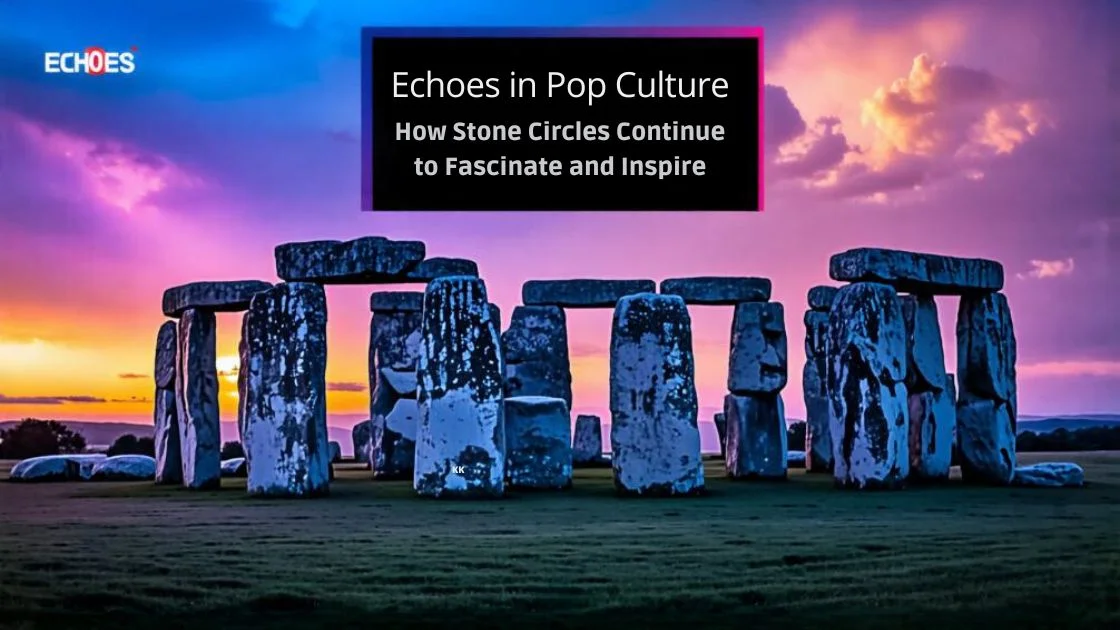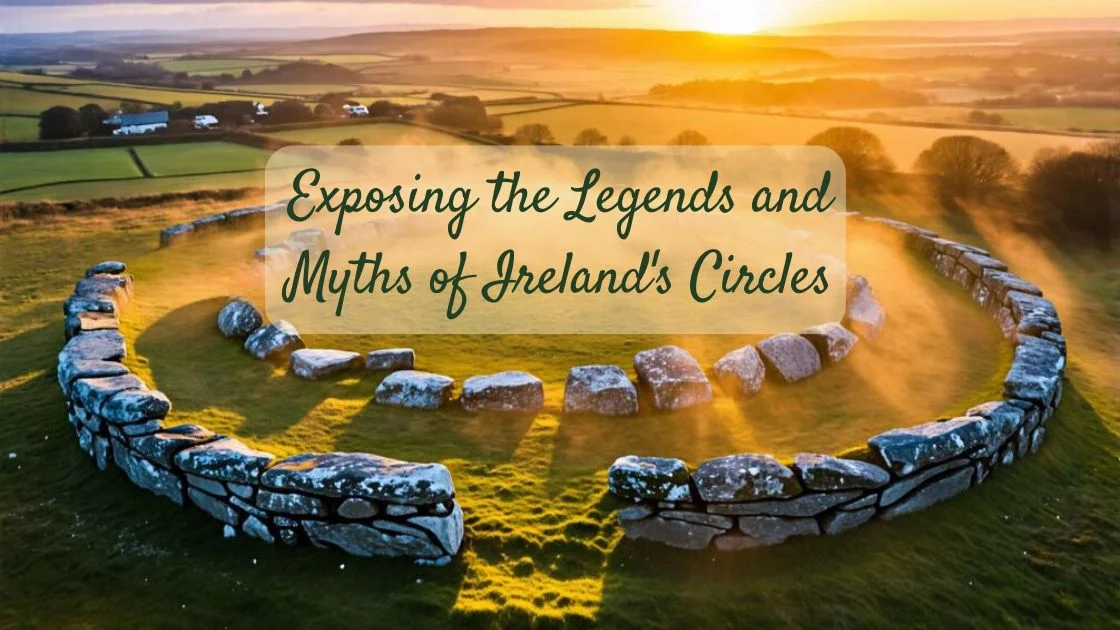You’re stepping into a battle for the past, where Northern Ireland’s ancient stones are under siege by time and neglect. You’ve got a role in protecting these Neolithic narratives, ensuring they’re not just memories.
Your voice and actions can shield these treasures from oblivion. Join the guardians of history in ‘Preserving the Stones: The Fight to Safeguard Northern Ireland’s Archaeological Treasures’—a call to arms for the freedom of our shared heritage.
It’s time to act.
Key Takeaways
- Threats to Northern Ireland’s archaeological treasures include weathering, erosion, rising seas, extreme weather, vandalism, development pressures, and tourism impacts.
- Lack of awareness and community engagement can lead to neglect of these sites, while informed locals can help manage tourism and advocate for legal protections.
- Insufficient government funding and policies pose challenges to safeguarding these treasures, with inadequate funding and budget constraints hindering long-term conservation strategies.
- Ongoing preservation efforts by agencies like NIEA and National Trust, as well as community-driven stewardship, aim to mend decay and deterioration, monitor sites, and ensure the endurance of these stone monuments.
Introduction: Overview of Northern Ireland’s rich archaeological heritage and stone relics dating back to the Neolithic period
You’ll find Northern Ireland’s landscape dotted with ancient stone relics, harking back to the Neolithic period and beyond, which stand as silent witnesses to a rich archaeological heritage.
These monuments, from the mystifying stone circles to the enigmatic chambered cairns, aren’t just remnants of history; they’re the soul of Northern Ireland archaeology, emblematic of a time when freedom in spirituality and expression flourished across these lands.
As stewards of these treasures, you must advocate for their protection and ensure their tales aren’t lost to the ravages of time.
It’s a delicate balance to strike—safeguarding these sites while keeping them accessible for you to explore and be inspired by.
The Threats Facing Northern Ireland’s Archaeological Treasures
You’re standing amidst history when you visit Northern Ireland’s ancient sites. These irreplaceable treasures are under siege, facing relentless natural forces and human activities that threaten their preservation.
Weathering, erosion, and the undeniable impact of climate change are gradually eroding the very fabric of these stone monuments. Over time, these forces wear away at the structures, erasing the intricate details and diminishing their historical significance.
On the human front, vandalism, unchecked development, and the wear and tear from tourism are exacerbating the situation. Deliberate acts of destruction and negligence contribute to the deterioration of these sites. Uncontrolled development encroaches upon the surrounding areas, diminishing the integrity and authenticity of the ancient sites. The constant influx of tourists, while beneficial for the local economy, adds to the wear and tear on these fragile structures.
Unfortunately, the measures in place to protect and preserve these sites fall short. Funding and policy efforts are often inadequate to mount an effective defense against the forces eroding these ancient treasures. Without proper resources and support, the battle to safeguard Northern Ireland’s ancient sites becomes increasingly challenging.
It is crucial to recognize the urgency of the situation and take action to protect and preserve these invaluable pieces of history. Through increased funding, strengthened policies, and enhanced public awareness, we can work together to ensure that future generations can continue to experience the awe-inspiring beauty and rich cultural heritage found in Northern Ireland’s ancient sites.
Natural threats like weathering, erosion, climate change
As you explore Northern Ireland’s ancient landscapes, it’s essential to recognize that numerous sites face the relentless pressures of weathering, erosion, and the ever-growing impact of climate change.
- Weathering: Stone structures gradually decay due to constant exposure to the elements.
- Erosion: Soil and rock supporting these monuments are washed away over time.
- Rising Seas: Climate change-induced sea-level rise threatens coastal heritage sites.
- Extreme Weather: More frequent storms and harsh conditions exacerbate the deterioration.
- Temperature Fluctuations: The freeze-thaw cycle widens cracks in ancient stonework.
You’re not just a visitor; you’re a guardian of a legacy. Protecting these treasures requires awareness and action against the natural threats that loom over them, particularly the pervasive challenge of climate change.
Human threats like vandalism, development pressures, tourism impacts
While you explore the storied past of Northern Ireland, it’s important to understand that vandalism, unchecked development, and the wear from increasing tourism pose significant risks to these ancient stones.
Acts of vandalism not only deface but can permanently damage these irreplaceable markers of history. Development pressures threaten to encroach upon or even demolish sites for new construction, heedless of their cultural significance. Meanwhile, the footfall of visitors, while valuable for awareness and local economies, can lead to wear and degradation of these fragile sites.
It’s vital to strike a balance that respects your right to experience these treasures while guarding them fiercely for future generations. Your role is crucial: tread lightly, advocate for responsible development, and condemn vandalism to ensure these stones stand as enduring testaments to Northern Ireland’s rich heritage.
Lack of public awareness and community engagement
Despite these challenges, another significant threat to Northern Ireland’s archaeological sites is the lack of public awareness and community engagement. You mightn’t realize it, but your understanding and involvement are crucial for the preservation of these ancient treasures.
Here’s why:
- Invisibility: Without public awareness, these sites risk becoming forgotten, leading to neglect.
- Stewardship: Engaged communities act as guardians, deterring harmful activities like vandalism.
- Advocacy: You can’t fight for what you don’t know exists. Knowledge empowers advocacy for legal protections.
- Cultural Connection: Awareness fosters a sense of pride and connection to heritage, inspiring preservation efforts.
- Tourism Balance: Informed locals can help manage tourism to ensure it supports rather than damages sites.
Insufficient government funding and policies
You’ll find that the preservation of Northern Ireland’s archaeological sites is severely hampered by insufficient government funding and policies. Despite the profound cultural significance and potential for tourism, the current investment in safeguarding these ancient treasures falls short.
Without adequate funding for archaeology, the very essence of Northern Ireland’s heritage risks being eroded alongside the stones themselves. Agencies like the NIEA strive to protect and maintain these sites, yet they’re shackled by budgetary constraints, limiting their ability to implement long-term conservation strategies.
It’s a delicate dance between facilitating public access and ensuring the survival of these irreplaceable monuments. As stewards of freedom, you must recognize that protecting these sites from the ravages of time, neglect, and modern encroachment is a battle that requires not just awareness but also robust support and proactive policies.
Ongoing Preservation Efforts
You’re stepping into a world where the past’s echo is tangible in the stones that have weathered time’s relentless march.
Agencies like the NIEA and the National Trust, alongside local archaeology groups, tirelessly work to mend the ravages of decay and deterioration.
Their conservation projects not only repair but also aim to foster sustainable practices and encourage community-driven stewardship, ensuring these treasures endure for future generations.
Work of agencies like NIEA, National Trust, local archaeology groups
While you explore Northern Ireland’s ancient legacies, agencies like the Northern Ireland Environment Agency and the National Trust, alongside local archaeology groups, are actively working to preserve these irreplaceable stone monuments. They’re the unsung guardians of your beloved heritage, ensuring that the freedom to marvel at these sites remains for generations to come.
- Monitoring Sites: Regular checks to assess erosion and other risks.
- Public Engagement: Educating visitors on the importance of preservation.
- Legal Protections: Advocating for stronger laws to protect against vandalism and neglect.
- Conservation Projects: Applying sustainable methods to repair and maintain structures.
- Collaborative Efforts: Partnering with the Department for Communities NI for integrated heritage management.
Every stone tells a story, and these organizations ensure that the narrative of Northern Ireland’s deep-rooted history continues to be told.
Conservation projects to repair damage and deterioration
Your heritage’s protectors tirelessly initiate conservation projects to repair damage and deterioration, ensuring that Northern Ireland’s stone monuments endure the test of time. These endeavors aren’t just acts of maintenance; they’re battles against the relentless forces of nature and human neglect.
The Northern Ireland Environment Agency and its partner organizations employ cutting-edge techniques and traditional craftsmanship to stabilize and restore these ancient sentinels.
Whether it’s re-pointing weathered mortar at Dunluce Castle or safeguarding the enigmatic standing stones from erosion, each action is a step towards immortality for these storied landmarks.
Your right to experience these wonders is matched by a duty to preserve them, a balance struck by thoughtful conservation that honors both the past and the freedom to witness history unspoiled.
Promoting sustainability and community-led projects
Community involvement is key to the sustainability of Northern Ireland’s historic sites, as locals take ownership of safeguarding the area’s archaeological legacy. Active community engagement fosters a shared responsibility, ensuring that these treasures aren’t just preserved for future generations, but also celebrated as living testaments to your rich heritage.
Here’s what you can do:
- Participate in local heritage groups to raise awareness.
- Volunteer for site maintenance and monitoring programs.
- Support policies that prioritize archaeological conservation.
- Engage with educational programs that teach the value of preservation.
- Advocate for sustainable tourism that respects historical sites.
Your protective efforts not only maintain the integrity of these sites but also empower your community to influence stewardship and promote a legacy of freedom and respect for the past.
Key Archaeological Sites Under Threat
You’re now standing at the precipice of a critical issue: the protection of key archaeological sites in Northern Ireland.
Landmarks such as the Navan Centre, the majestic Giant’s Ring, and the storied Carrickfergus Castle face mounting threats from both natural decay and human activities.
Assessing their current condition reveals a tapestry of damage and risks, underscoring the urgent need for action to shield these irreplaceable treasures.
Navan Centre, Giant’s Ring, Carrickfergus Castle
Three iconic archaeological sites in Northern Ireland—Navan Centre, Giant’s Ring, and Carrickfergus Castle—are currently facing threats that could compromise their structural integrity and historical value. You should be aware that these landmarks aren’t just relics; they’re beacons of your cultural legacy, now at risk.
Here’s what’s at stake:
- Navan Centre: This ancient ceremonial site is battling against time and human interference.
- Giant’s Ring: Erosion and unchecked visitor traffic threaten this Neolithic treasure.
- Carrickfergus Castle: Coastal erosion and modern pollution are assaulting this medieval fortress.
- Conservation Efforts: Underfunded and overwhelmed, yet crucial for safeguarding these sites.
- Your Role: Advocate, visit responsibly, and support preservation initiatives.
You’re not just an observer; you’re a guardian of freedom and history. Protecting these sites means preserving your right to connect with a past that defines the present.
Current condition, damage and risks
Amidst these challenges, you’ll find that key archaeological sites like the Navan Centre, Giant’s Ring, and Carrickfergus Castle are now confronting a critical juncture due to ongoing damage and various risks.
The threats to archaeological sites are multifaceted; erosion whittles away at ancient stones, while human activities—from graffiti to foot traffic—exacerbate their fragility. Budget constraints often stymie the efforts needed to counter these risks effectively.
As stewards of freedom, you’re called to protect these irreplaceable portals to the past. The balance between accessibility and preservation is delicate but necessary. You’re not just safeguarding stones, but the stories and heritage they embody.
It’s a battle against time and negligence, one that demands vigilance and a collective commitment to ensure these treasures endure.
The Wider Significance of Safeguarding Archaeological Heritage
You’re standing on the precipice of losing not just stones, but the storied chapters of Northern Ireland’s cultural identity.
Each site that’s preserved bolsters tourism, educates future generations, and is a testament to the resilience of history.
Collaborating with stakeholders like Queen’s University Belfast and the Ulster Museum is vital to ensure these treasures withstand the test of time.
Cultural identity, tourism, education
Your appreciation for Northern Ireland’s unique cultural identity is deepened by the preservation of its numerous archaeological sites, which also bolster tourism and serve educational purposes. When these ancient stones stand safeguarded, they fortify the fabric of the community, allowing you to connect with ancestral narratives and engage with history hands-on.
Sustainable tourism hinges on such treasures, providing a draw for visitors while nurturing respect for heritage.
- Cultural Threads: Witness the tangible legacy of your forebears.
- Sustainable Tourism: Enjoy and protect the beauty without leaving scars.
- Educational Journeys: Learn from the stones, their silent stories educating generations.
- Community Pride: Share in the collective custodianship of your past.
- Economic Boost: Welcome the world to your door, with heritage as the key.
Working with stakeholders like Queen’s University Belfast, Ulster Museum
Collaborating with key institutions like Queen’s University Belfast and the Ulster Museum, you’ll uncover the wider importance of preserving Northern Ireland’s archaeological heritage. These partnerships are vital in safeguarding the stones that aren’t just relics, but narrators of a story stretching back millennia.
Engaging with experts from Queen’s University Belfast, you tap into a reservoir of knowledge essential for informed conservation strategies. The Ulster Museum serves as a guardian of these stories, sharing them with the world and highlighting the need for their protection.
Your role in this collaboration is clear: to be the voice that advocates for these stones’ survival, ensuring they’re not silenced by negligence. It’s a noble cause, preserving not only history but the freedom to understand and appreciate our shared past.
A Way Forward
You’ve seen the weathered faces of our ancient stones and understood their silent plea for protection.
It’s time to bolster government funding and policy frameworks to ensure these irreplaceable links to our heritage aren’t lost.
Increasing government funding and policy support
To effectively protect Northern Ireland’s archaeological sites, increased government funding and stronger policy support are essential components in the preservation strategy. Safeguarding these treasures isn’t just about the past—it’s about ensuring future generations enjoy the freedom to explore their heritage.
Here’s what’s needed:
- A significant boost in government funding to support conservation efforts.
- The implementation of robust government policies that prioritize site preservation.
- Increased collaboration between government bodies and heritage organizations.
- Public education initiatives to foster a protective attitude towards these sites.
- Legal measures to deter and penalize vandalism and unauthorized development.
More community engagement and public education
You have a critical role to play in preserving the ancient stoneworks that are Northern Ireland’s pride.
By engaging with sustainable tourism practices and advocating for responsible site management, you help ensure these treasures endure for future generations.
Your awareness and involvement can tip the balance towards effective preservation and away from irreversible damage.
Sustainable tourism and site management
Amid the struggle to preserve Northern Ireland’s archaeological sites, you’ll find that sustainable tourism and effective site management hinge on increased community involvement and educational outreach.
Encourage responsible visitation practices.
Implement eco-friendly facilities.
Conduct workshops on heritage preservation.
Develop partnerships with local businesses.
Foster pride in local history.
These steps are crucial for safeguarding your cherished landscapes and ensuring freedom to enjoy them for generations to come.
Support from all stakeholders to protect Northern Ireland’s ancient stones
Your support, along with that of countless others, is crucial in the fight to protect Northern Ireland’s historic stone monuments from ongoing threats. These ancient stones aren’t just relics; they’re the embodiment of our heritage, standing as silent guardians of a past that still whispers to those who listen. The preservation efforts required to safeguard these sites demand collective vigilance and action.
All stakeholders, including you, heritage trusts, conservation advocates, and government bodies like the NIEA, must unite to fortify our approach against vandalism, weather erosion, and inappropriate development. It’s about balance—ensuring these stones remain touchstones for future generations without sacrificing the freedom to experience their majesty.
Together, we can be the bulwark that these archaeological treasures so desperately need.
Conclusion
As you’ve seen, safeguarding Northern Ireland’s ancient stones is more than a conservation effort; it’s a call to protect the bedrock of cultural identity.
You’re part of a community united by the responsibility to preserve these irreplaceable treasures for future generations.
Together, let’s ensure the story these stones tell won’t fade into history, but will be a legacy that continues to inspire.
Message of hope and unity around shared goal of safeguarding cultural heritage
While you explore the windswept landscapes that cradle Northern Ireland’s ancient stones, it’s vital to remember that we’re all part of the enduring legacy that unites us in preserving these irreplaceable treasures.
Protecting our cultural heritage isn’t just a task—it’s a testament to our respect for history and our commitment to the future.
Here’s how you can join in the effort:
- Support local preservation groups
- Advocate for responsible tourism
- Educate others about the significance of these sites
- Participate in community clean-up events
- Lobby for stronger legal protections
Together, we can ensure that the story of Northern Ireland’s past continues to inspire and inform generations to come.
Stand firm in your resolve to shield our shared legacy.
Conclusion
As you stand among Northern Ireland’s timeless stones, remember that their preservation rests in our hands.
Together, we must champion their protection, balancing accessibility with the safeguarding of our shared heritage.
Act now, for every moment counts in the race to shield these narratives from the relentless march of time.
It’s our collective duty to ensure that these ancient whispers of history aren’t silenced, but heard by generations to come.



